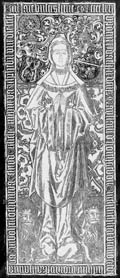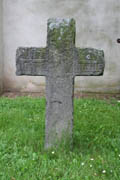The variety of medieval tomb monuments
Medieval tomb monuments come in many different forms, from incised slabs,
brasses
and wall memorials
to large sculpted tombs
that carry effigies of the deceased. Whereas the majority of tomb monuments are situated inside churches and cathedrals,
we also still find medieval stone memorial crosses
and slabs in churchyards.
Medieval monuments were usually decorated with colour, although most original polychromy has been lost over time.
Even the outlines on incised slabs were often filled with mastic or colour for contrast, but such fillers have
usually disappeared. The present colours on the double tomb of Gerhard IV,
Count of Guelders and Zutphen (d. 1229), and his wife Margaretha of Brabant (d. 1231) at Roermond Minster are
the work of Pierre Cuypers in 1873. Yet such later repainting can give us an idea of the once colourful appearance
of medieval tombs.
The most prestigious position for burial was near the high altar: here founders were often laid to rest. Thus the
Count and Countess of Guelders and Zutphen were buried under the floor at the church crossing, right in the centre of
the Minster in Roermond. The monument does not actually contain their bodies, but is positioned directly above their
graves. The body of Catherine of Bourbon,
Duchess of Guelders (d. 1469), was laid to rest in a vault
underneath the floor of the Stevenskerk in Nijmegen. Her tomb monument features not a sculpted effigy but a large
brass with a representation of the duchess; around the sides of the tomb chest are smaller brass plates with images
of the twelve apostles, figures of mourners ('weepers') and ancestral coats of arms.
Brasses and incised slabs were also often placed directly on the floor. The term
'brass' is a misnomer: the metal is a
copper-zinc alloy that was known by the French term laiton ('latten'). Brass plates were originally imported
from Flanders and fitted into stone slabs. The engraved plates were often decorated with silver or enamel.
Unfortunately the majority of brasses have been lifted from their slabs, leaving only an indent:
the metal was used for scrap. Still a few
examples survive in the Netherlands.
|



|
Disclaimer:
2011: web design by Charlotte Dikken (UU). This website was tested and works on Internet Explorer, Opera and Firefox
and is best viewed on a fully maximized screen. Some of the features on this site use JavaScript.

Last updated on: 7 May 2014.
|
|
|